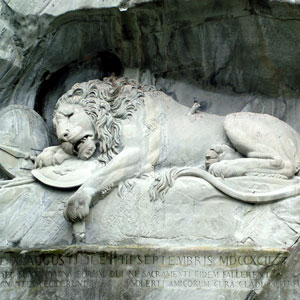The Lion of Lucerne
Life continually proves to me that it is pointless to doubt or argue with your parents.
Case in point: over the years Mom and Dad repeatedly told me about an incredible Lion Monument they saw carved into a cliff in Lucerne, Switzerland. To say that I was less than enthused about seeing it is an understatement.
However, on my trip to Lucerne, you guessed it, the Lion of Lucerne.
As with everything, it’s the story behind the Lion that makes the difference.
As you may know, the Swiss Guard defends Vatican City and the Pope. In their bright uniforms with poofy short pants (designed by none other than Michelangelo) it’s a little hard to take them seriously.
From the early 1600’s a regiment of the Swiss Guard also served as part of the Royal Household of France. On a fateful day in 1792, wearing their elaborate uniforms and facing insurmountable odds, they defended to the death King Louis XVI of France, a Catholic King.
On August 10, 1792, Revolutionaries stormed the Tuileries Palace (built by Catherine De Medici and burned to the ground after the Revolution). King Louis and Queen Marie Antoinette had been forced to leave their palace at Versailles and take up residence with their family there.
Even after receiving a note from the King himself allowing them to disband, the Swiss fought on, low on ammunition and facing a hopeless situation. They were overrun by the superior numbers of the angry mob.
Of the 950 Swiss Guards stationed at the Tuileries Palace, more than 600 were killed in the fight, 200 more died of their wounds and a few were later tried and guillotined, still wearing their bright uniforms. Less than 100 were said to have survived. (Even household servants were chased through the palace grounds and massacred).
The Lion of Lucerne was paid for with funds collected by the Swiss in 1818 and is dedicated to “The Loyalty and Bravery of the Swiss”. Officer Karl Pfyffer von Altishofen, who had been on leave in Lucerne at the time of the massacre, began the fund.
Located in the heart of the bustling old city of Lucerne, this magnificent Lion somehow found a peaceful resting place. To find him you wind your way through the narrow city streets, surrounded by ancient buildings, looking up at medieval stone fortifications.
At the dead end of a pedestrian lane, in a miraculously quiet and idyllic spot, the enormous dying lion is carved into the face of a rock cliff, a reflecting pool beneath him. He is impaled by a spear and covering with his dieing body a shield bearing the fleur-de-lis of the French Monarchy.
Mark Twain saw the Lion Monument and wrote a moving tribute to it in his book A Tramp Abroad in 1880.
Of all the things I saw in Switzerland, the Lion of Lucerne was the most impressive due to the bravery and dedication it represents. It is impossible to be unmoved by the story of the Swiss Guard and their stand against mob rule in France, 1792.
More next week, until then, think about Switzerland to help you cope with our unrelenting heat and humidity wave.

